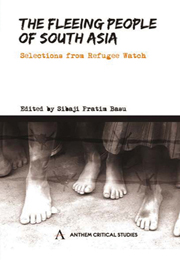Foreword by Ranabir Samaddar
Published online by Cambridge University Press: 05 March 2012
Summary
Refugee Watch came into the world in 1998 – exactly a decade ago – for the task of documenting the flows of forced migration in South Asia. It was probably the first such initiative in this region followed by an imaginative publication from Dhaka, and then other publications and initiatives. Refugee Watch while being a proud member of the human rights community of the region, which is aware of its responsibility towards victims of forced migration, continues to be a unique publication. From its inception, the initiative marked its regional coverage in its structure, authorship, news and style. It gradually brought before the readers the news of other regions, the relevant analyses, informed comments, and commentaries on campaigns and events relating to forced migration. It also aimed to be distinct, and readers will realize that this remains the case till now, on two counts. First, it did not want to be a scholastic publication. It brought out creative writings, narratives, critical legal opinions, experiences of the refugees themselves along with commentaries on partition refugees in a comparative light, and above all fresh perspectives infused with a sense of history. In this sense it aimed at not only being inter-disciplinary, but also at crossing the divide of academic publication and commitment bound writings and presentations. Second, in Refugee Watch the refugee appeared not only as a particular category of the displaced, but also as a figure of all kinds of displacement and forced migration.
- Type
- Chapter
- Information
- The Fleeing People of South AsiaSelections from Refugee Watch, pp. xv - xviPublisher: Anthem PressPrint publication year: 2009



